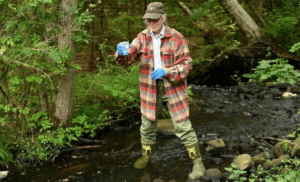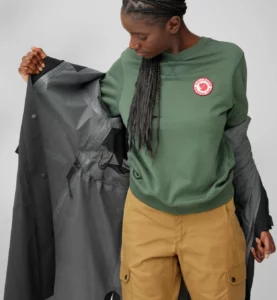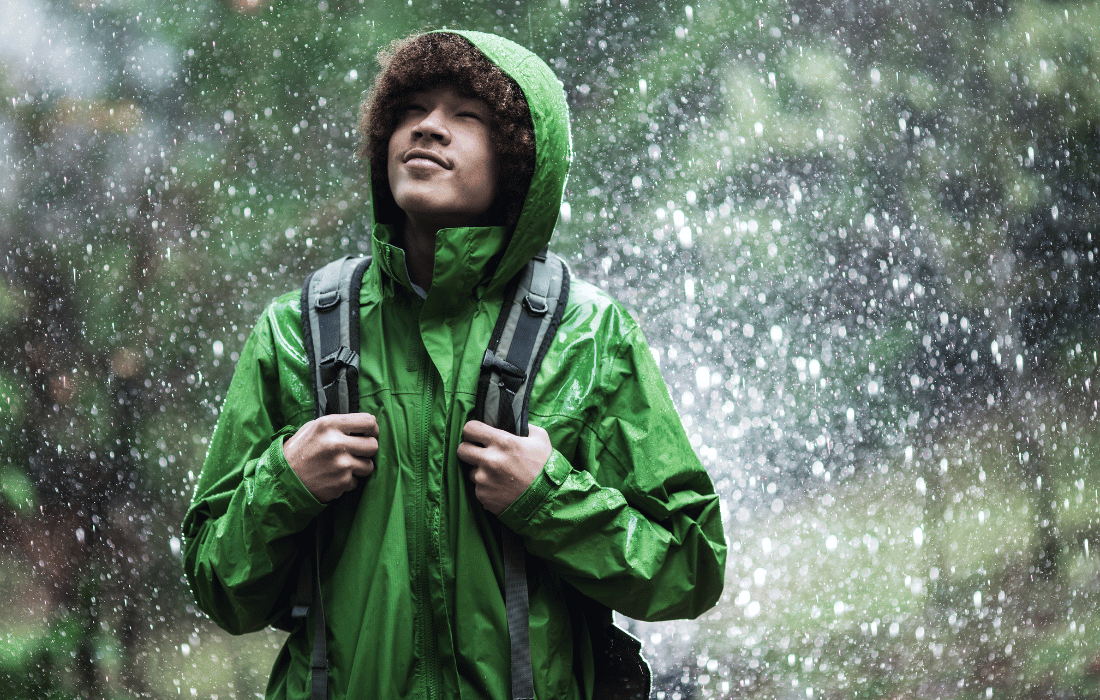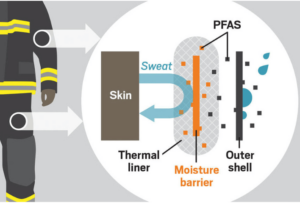Picture this: you invest in high-quality rain gear, you’re feeling all spiffy and good thinking you’re shielding yourself from the elements – “A bit of rain won’t stop me from my hikes!” – but in reality, you’re exposing yourself to toxic chemicals. Staying dry when out in nature can be a lifesaver, but what you’re wearing might be harming your health in ways you never imagined.
PFAS, or per- and polyfluoroalkyl substances, are a class of synthetic chemicals that have become nearly synonymous with waterproof and stain-resistant products. Unfortunately, these “forever chemicals” don’t break down in the environment or the human body, leading to widespread contamination and serious health concerns.
So why are these toxic chemicals still being used in rain gear? And what does that mean for your health and the environment? This article will break down how PFAS exposure from rain gear is a serious problem, why companies continue using them, and what you can do to protect yourself and the planet.
What Are PFAS, and Why Are They in Your Rain Gear?
PFAS (per- and polyfluoroalkyl substances) are a group of man-made chemicals used for their ability to repel water, oil, and stains. First developed in the mid-1900s, these chemicals have been incorporated into everything from nonstick cookware to fast-food packaging – and, of course, rain-resistant outdoor gear.
Many outdoor brands historically marketed PFAS-treated gear as “essential” for adventurers, hikers, and even everyday commuters. Whether it’s a rain jacket, waterproof boots, or a camping tent, PFAS ensure that water beads off rather than soaking in. Unfortunately, this convenience comes with a high cost.
Unlike natural materials that degrade over time, PFAS persist indefinitely. Once they enter the environment, they don’t break down, accumulating in soil, water, wildlife, and, ultimately, human bodies. Studies show that PFAS can be detected in nearly everyone’s blood, highlighting the widespread exposure caused by everyday products – including rain gear.
Health Risks of PFAS Exposure
Absorption & Exposure Pathways
Wearing PFAS-treated rain gear doesn’t just mean you’re repelling water – it also means you’re exposing yourself to these toxic chemicals in multiple ways:
- Skin Absorption: PFAS can transfer from clothing onto your skin,
 particularly with prolonged wear.
particularly with prolonged wear. - Inhalation: PFAS-treated gear can release airborne particles, especially when exposed to heat or friction.
- Contaminated Water & Food: PFAS accumulate in drinking water and food sources, making exposure even more widespread.
Known Health Impacts
Research on PFAS exposure has uncovered alarming health risks, including:
- Hormone Disruption & Thyroid Issues – PFAS interfere with endocrine function, leading to imbalances that affect metabolism, growth, and reproductive health.
- Immune System Suppression – Exposure has been linked to reduced vaccine efficacy and increased susceptibility to infections.
- Cancer Risks – Certain PFAS are classified as possible carcinogens, with links to kidney, liver, and testicular cancer.
- Fertility & Pregnancy Complications – PFAS exposure has been associated with lower sperm counts, pregnancy-induced hypertension, and developmental issues in infants.
- Cognitive & Behavioral Impacts – Studies suggest PFAS exposure in children can lead to developmental delays and behavioral issues.
With such heavy risks, it’s pretty shocking that PFAS remain so common in consumer goods.
Environmental Impact of PFAS
PFAS don’t just affect humans – they’re a serious problem for the natural world around us as well.
Water Contamination
One of the biggest concerns is PFAS contamination in drinking water. These chemicals seep into rivers, lakes, and groundwater, making their way into municipal water supplies. Because they don’t break down, they persist for decades, affecting entire communities.

Bioaccumulation in Wildlife
PFAS have been found in fish, birds, and even Arctic animals, showing how far-reaching the contamination is. Once in the food chain, these chemicals accumulate, leading to toxic effects on wildlife and potentially harming those who consume affected animals.
Persistence in Soil & Air
PFAS are resistant to degradation, meaning they accumulate in the soil, affecting plant life and agriculture. Airborne particles from PFAS-treated products also contribute to pollution, further expanding the environmental footprint of these chemicals.
Why Are PFAS Still Allowed in Rain Gear?
Despite the known risks, PFAS are still prevalent in consumer products, particularly in outdoor gear. Why? The answer lies in a mix of corporate interests, greenwashing, and regulatory failures.
Corporate Interests & Greenwashing
Many companies claim to be phasing out PFAS, but the reality is more complicated. Some brands have replaced older PFAS formulations with newer, less-studied versions that may still pose health risks. Others use misleading labels like “PFC-free,” which might only refer to certain types of PFAS rather than eliminating them entirely.
Regulatory Failures
While some governments have started regulating PFAS, enforcement remains slow. In the U.S., for example, the EPA has begun cracking down on certain PFAS in drinking water but has yet to implement a full ban in consumer products. This regulatory lag allows manufacturers to continue producing and selling PFAS-treated rain gear with little accountability.
What Can You Do? Safer Rain Gear & Solutions
The good news is that alternatives exist. Look for brands committed to eliminating PFAS from their products, such as:
- Patagonia – Has pledged to phase out PFAS from all products by 2024.
- Fjällräven – Uses fluorocarbon-free waterproofing on their outdoor gear.
- Vaude – A European brand known for sustainable, PFAS-free materials.
Alternative materials include:
- Waxed Cotton – A natural and effective water-resistant option.
- Polyurethane (PU) Coatings – Supposedly a safer synthetic alternative for waterproofing.
- Recycled Polyester with Water-Repellent Treatments – Some brands use non-toxic, biodegradable coatings.

Cleaning & Repelling Water Without PFAS
If you already own PFAS-treated gear, consider safer waterproofing methods:
- Beeswax-Based Waterproofing – Natural and effective for items like jackets and boots.
- Plant-Based Sprays – Some companies now offer non-toxic waterproofing alternatives.
- Proper Disposal – Avoid throwing PFAS-treated gear in landfills where chemicals can leach into the soil and water.
Advocacy & Consumer Power
Consumer demand has already pressured some brands to move away from PFAS. You can help by:
- Supporting brands that are transparent about PFAS removal.
- Signing petitions and supporting legislative efforts to ban PFAS.
- Spreading awareness about the dangers of PFAS and their alternatives.
Final Thoughts on Rethinking Rain Gear
The days of blindly trusting outdoor gear brands are over. PFAS are harming both our health and the planet, and the responsibility to demand change lies with consumers. By choosing safer alternatives, pressuring companies to eliminate PFAS, and advocating for stronger regulations, we can take a stand against toxic chemicals in our everyday products.
Next time you’re in the market for rain gear, ask yourself: Is staying dry worth the long-term health and environmental risks? With better alternatives available, the answer is clear. It’s time to ditch PFAS and embrace truly sustainable rain protection.


 particularly with prolonged wear.
particularly with prolonged wear.





